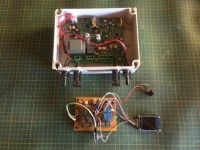PV Solar Energy Management System

Limited Energy availability in Rural South Africa is usually done by burning carbon rich fuels. This project provides an AI controlled limited Photovoltaic Energy controller to provide energy where it is best needed, depending on time of day, weather and sun availability. This then optimises the use of the solar electricity and provides a relatively cheap source of energy. The elder rural inhabitants have limited educational skills and the AI in this system plans to overcome their technical limits.
PV SOLAR ENERGY MANAGEMENT SYSTEM
Introduction
The demand to reduce carbon emissions and limit global warming is one o f the inspiration of this project. The use of cheaper green energy is becoming more attractive as an energy source to meet these demands. With a small Solar Panel setup and some intelligent energy management, a useful relatively inexpensive electrical power source can be utilised in rural areas which have limited or no electricity.
The use of Artificial Intelligence (AI) in the controller will aid the use, who has limited technical and educational skills in automatically setting up the system to the users needs. The voice commands in the
AI controller will also assist to minimise and even eliminate the requirements for push buttons on the system, which can be a bugbear for illiterate elderly users.
Factors in favour of the Project
Advances in green energy products and micro controller technology are an ideal way to utilise these advances to the benefit of the communities with limited electrical energy
- South Africa and indeed most of Africa has an abundance of sunlight.
- PV panels are coming down in price.
- LED lights are becoming more efficient.
- More intelligent controllers are becoming available
A low cost geyser controller utilising PV panels is available on the market that can provide hot water with as little as four solar panels. However once the geyser is up to the required temperature and the geyser thermostat, the solar energy is wasted and lost.
Design Aims
This project aims to provide an intelligent Energy Management Controller that will move the energy for four solar panels or more, to the required load once the Geyser is up to the required temperature. This is done by means of switching in and out certain Solar Panels to different load.This then optimises the use of the "Free" available electrically generated energy by the solar panels and limits the wastage of this electricity..
Some of the loads under consideration for switching to are:
- Hot water via the geyser, for washing as well as sterilizing the water.
- Large Battery charging for lights, radios, music and TV entertainment
- Small chargers for Cell phones, and torches.
- Electrical heaters
- Inverters
The current microcontroller, an ESP8266, has WiFi capabilities on board and this is used to connect to the internet and display the energy and status results on a Web Page. Remote control and Over The Air (OTA) capabilities is then also available, depending on the Internet coverage in the area.
The one used on this prototype project is the Adafruit IO website, as this has useful examples and is easy to implement. Hats off to the Adafruit team as this is an excellent site to use.
Implementation
The prototype has been built on standard vero-board. The plan was to use the MAX78000 as the intelligent controller, however the deliver of the board was delayed as postal services in South Africa are much to be desired.
Therefore a ModeMCU 8266 was used for the initial prototype while waiting for the MAX78000.
This was done to test the concept and check that the PV switching worked.
The plan would be to then transfer the software to the MAX board and further development.
The switching of the Solar Panels is done via high voltage/Current relays as this is DC current switching and arcing can occur with fast DC current switching.
Project Status.
The project is in the initial design and implementation stage and the hardware has been completed. The high voltage relays have been built and tested.
The version 1 of the software has been implemented and tested and the energy monitoring can be seen on the Adafruit IO site. A screen dump of this is attached to the documentation.
Documentation
The uploaded documentation is shots of the prototype main controller, the High Voltage Relay Switches and the commercially available low cost geyser controller. A screen shot of the Adafruit IO site is also uploaded.
A document of the software flowchart to indicate the thinking is also included. This will obviously be expanded to include the AI component as soon as the MAX board is implemented.
Conclusion
It can be seen that a large amount of planning, development and software writing has gone into this project and I hope this convinces the judges that is can qualify as consideration for the contest.
There is still a large amount of work to be done and the delay of the MAX board has stalled some of the work. However this cannot be the primary excuse and it was underestimated as to how long the implementation of the hardware would be. COVID 2019 has also not helped in the delivery of some of the components.
I would like to thank Elektor for the opportunity in using the MAX board and for spurring me on to work more diligently and try to complete the project.
The work on the project will continue, notwithstanding the deadline of the contest.
I am an Electronic Engineer by hear and mind and thoroughly enjoyed this challenge.!




Discussie (0 opmerking(en))